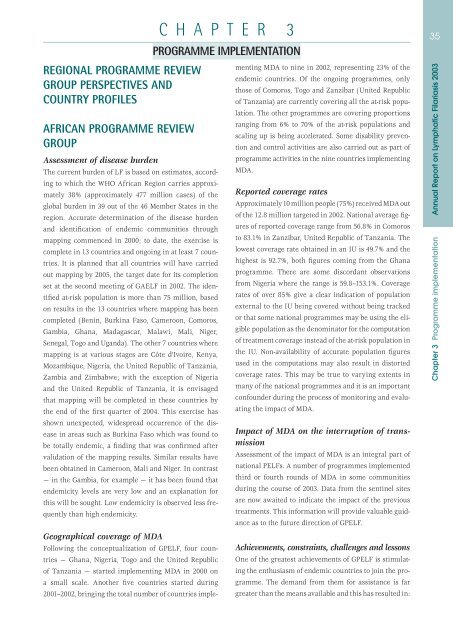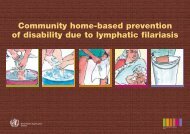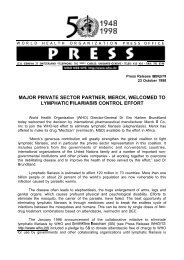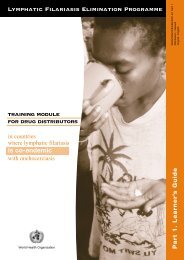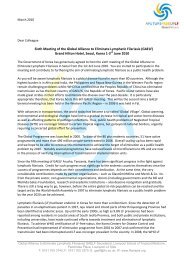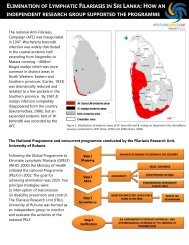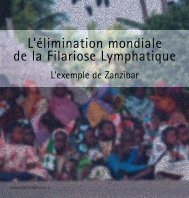Global Programme to Eliminate Lymphatic Filariasis ... - libdoc.who.int
Global Programme to Eliminate Lymphatic Filariasis ... - libdoc.who.int
Global Programme to Eliminate Lymphatic Filariasis ... - libdoc.who.int
You also want an ePaper? Increase the reach of your titles
YUMPU automatically turns print PDFs into web optimized ePapers that Google loves.
C H A P T E R 3PROGRAMME IMPLEMENTATIONREGIONAL PROGRAMME REVIEWGROUP PERSPECTIVES ANDCOUNTRY PROFILESAFRICAN PROGRAMME REVIEWGROUPAssessment of disease burdenThe current burden of LF is based on estimates, according<strong>to</strong> which the WHO African Region carries approximately38% (approximately 477 million cases) of theglobal burden in 39 out of the 46 Member States in theregion. Accurate determination of the disease burdenand identification of endemic communities throughmapping commenced in 2000; <strong>to</strong> date, the exercise iscomplete in 13 countries and ongoing in at least 7 countries.It is planned that all countries will have carriedout mapping by 2005, the target date for its completionset at the second meeting of GAELF in 2002. The identifiedat-risk population is more than 75 million, basedon results in the 13 countries where mapping has beencompleted (Benin, Burkina Faso, Cameroon, Comoros,Gambia, Ghana, Madagascar, Malawi, Mali, Niger,Senegal, Togo and Uganda). The other 7 countries wheremapping is at various stages are Côte d’Ivoire, Kenya,Mozambique, Nigeria, the United Republic of Tanzania,Zambia and Zimbabwe; with the exception of Nigeriaand the United Republic of Tanzania, it is envisagedthat mapping will be completed in these countries bythe end of the first quarter of 2004. This exercise hasshown unexpected, widespread occurrence of the diseasein areas such as Burkina Faso which was found <strong>to</strong>be <strong>to</strong>tally endemic, a finding that was confirmed aftervalidation of the mapping results. Similar results havebeen obtained in Cameroon, Mali and Niger. In contrast— in the Gambia, for example — it has been found thatendemicity levels are very low and an explanation forthis will be sought. Low endemicity is observed less frequentlythan high endemicity.Geographical coverage of MDAFollowing the conceptualization of GPELF, four countries— Ghana, Nigeria, Togo and the United Republicof Tanzania — started implementing MDA in 2000 ona small scale. Another five countries started during2001–2002, bringing the <strong>to</strong>tal number of countries implementingMDA <strong>to</strong> nine in 2002, representing 23% of theendemic countries. Of the ongoing programmes, onlythose of Comoros, Togo and Zanzibar (United Republicof Tanzania) are currently covering all the at-risk population.The other programmes are covering proportionsranging from 6% <strong>to</strong> 70% of the at-risk populations andscaling up is being accelerated. Some disability preventionand control activities are also carried out as part ofprogramme activities in the nine countries implementingMDA.Reported coverage ratesApproximately 10 million people (75%) received MDA ou<strong>to</strong>f the 12.8 million targeted in 2002. National average figuresof reported coverage range from 56.8% in Comoros<strong>to</strong> 83.1% in Zanzibar, United Republic of Tanzania. Thelowest coverage rate obtained in an IU is 49.7% and thehighest is 92.7%, both figures coming from the Ghanaprogramme. There are some discordant observationsfrom Nigeria where the range is 59.8–153.1%. Coveragerates of over 85% give a clear indication of populationexternal <strong>to</strong> the IU being covered without being trackedor that some national programmes may be using the eligiblepopulation as the denomina<strong>to</strong>r for the computationof treatment coverage instead of the at-risk population <strong>int</strong>he IU. Non-availability of accurate population figuresused in the computations may also result in dis<strong>to</strong>rtedcoverage rates. This may be true <strong>to</strong> varying extents inmany of the national programmes and it is an importantconfounder during the process of moni<strong>to</strong>ring and evaluatingthe impact of MDA.Impact of MDA on the <strong>int</strong>erruption of transmissionAssessment of the impact of MDA is an <strong>int</strong>egral part ofnational PELFs. A number of programmes implementedthird or fourth rounds of MDA in some communitiesduring the course of 2003. Data from the sentinel sitesare now awaited <strong>to</strong> indicate the impact of the previoustreatments. This information will provide valuable guidanceas <strong>to</strong> the future direction of GPELF.Achievements, constra<strong>int</strong>s, challenges and lessonsOne of the greatest achievements of GPELF is stimulatingthe enthusiasm of endemic countries <strong>to</strong> join the programme.The demand from them for assistance is fargreater than the means available and this has resulted in:35Annual Report on <strong>Lymphatic</strong> <strong>Filariasis</strong> 2003Chapter 3 <strong>Programme</strong> implementation


